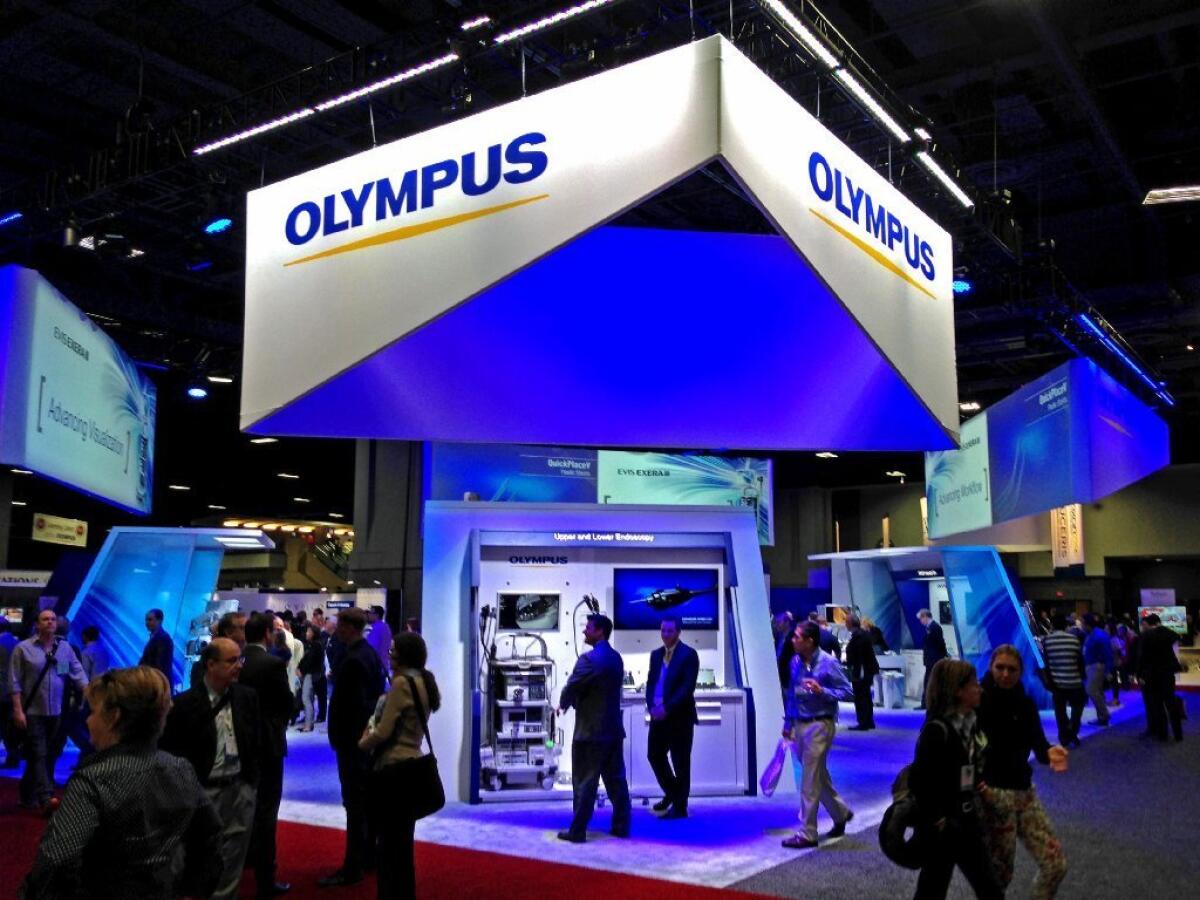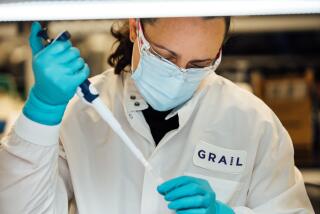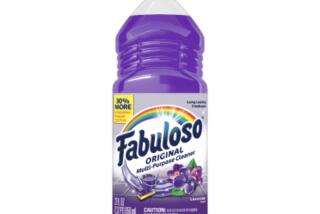Olympus told its U.S. executives no broad warning about tainted medical scopes was needed, despite superbug outbreaks

- Share via
Faced with superbug outbreaks in three countries by early 2013, Japanese device giant Olympus Corp. told U.S. executives not to issue a broad warning to American hospitals about potentially deadly infections from tainted medical scopes, internal emails show.
After two dozen infections were reported in French and Dutch hospitals, the company alerted European customers in January 2013 that a scope it manufactured could become contaminated.
A top Olympus executive in the U.S. grew concerned because the company was investigating a similar outbreak at a Pittsburgh hospital.
“Should [we] also be communicating to our users the information that [Olympus Europe] is communicating to their European users?” Laura Storms, vice president of regulatory and clinical affairs in Center Valley, Pa., asked in an email to Tokyo headquarters on Jan. 31, 2013.
No, that’s not necessary, said Susumu Nishina, the company’s chief manager for market quality administration in Tokyo in a Feb. 6, 2013, reply.
It is “not need[ed] to communicate to all the users actively,” Nishina wrote, because a company assessment of the risk to patients found it to be “acceptable.” However, he added that Storms should respond to questions from a customer.
Outbreaks of infection at hospitals in Los Angeles, Milwaukee, Denver and other cities followed over the next three years. All told, at least 35 people at U.S. hospitals have died since 2013 – three of them at UCLA’s Ronald Reagan Medical Center – after suffering infections from contaminated gastrointestinal scopes manufactured by Olympus, according to hospitals and public health officials.
Olympus’ actions – and inaction – are being closely examined in lawsuits by American patients and their families who contend that the manufacturer was negligent and might have prevented the outbreaks and deaths had it been more forthcoming. In addition, federal prosecutors are investigating Olympus’ handling of the infections – and the emails could become crucial evidence in any future case.
The company’s internal emails reveal conflicts inside Olympus over how to respond to a growing threat to patient safety, pitting U.S. executives against their superiors in Japan who had the final say. The emails were filed in a Pennsylvania court this month as part of a patient lawsuit and obtained by Kaiser Health News working in collaboration with the Los Angeles Times.
Olympus, which controls 85% of the U.S. market for gastrointestinal scopes, declined to comment on the emails, citing the pending litigation. It also declined to discuss the ongoing investigation by the U.S. attorney’s office in New Jersey.
Storms, Nishina and other company officials named in the emails didn’t respond to requests for comment.
Read the Olympus internal emails »
In a statement, the company said “patient safety is our top priority. The duodenoscope issue continues to receive the highest level of attention at Olympus, and we remain committed to working with the proper authorities and our stakeholders to understand and address the potential root causes.” The company declined to address why it didn’t feel it was necessary to inform U.S. hospitals when it was alerting those in Europe.
At the time of the safety alert in Europe, Olympus was already aware that design flaws could make it difficult to clean its duodenoscope for the next patient. Used in about 700,000 procedures annually in the U.S., the snake-like device is put down a patient’s throat to diagnose and treat problems in the digestive tract such as cancers and blockages in the bile duct.
As The Times reported in December, an investigator hired by Olympus and a Netherlands hospital concluded in a June 2012 report that the scope’s design could allow blood and tissue to become trapped, spreading bacteria from one patient to another. The independent expert called on Olympus to conduct a worldwide investigation and recall all its scopes if similar problems turned up.
A Senate report released this year said Olympus knew about at least three outbreaks – at hospitals in the Netherlands, France and Pittsburgh – affecting an estimated 46 patients when the European alert went out in early 2013.
Inside Olympus, the debate about how to respond to the emerging outbreaks in the U.S. came to a head on Feb. 6, 2013, the emails show.
Just a few hours after her exchange with the Tokyo official, Storms was confronted by her own U.S staff.
Read Olympus’ legal response »
Donny Shapiro, a director of regulatory affairs for Olympus in San Jose, Calif., sent an email to Storms and seven other employees with “Duodenoscope safety recall??” in the subject line. He cited the problems in Europe and results from the company’s microbiology lab showing Olympus scopes had tested positive for bacteria at the University of Pittsburgh Medical Center.
“Why was the alert only issued in Europe?” Shapiro asked his colleagues.
Six minutes later, Storms wrote back: “Donny, [Olympus Japan] has determined that a global communication is not required.”

Animation breaking down the uses and problems associated with the Olympus duodenoscope.
In these emails, Storms seemed to accept the decision by the corporate office. But in other messages to headquarters that same day, she challenged Japan executives’ handling of the investigation into the University of Pittsburgh Medical Center, or UPMC, outbreak. The hospital initially linked one contaminated scope to 18 sickened patients but later downgraded that total to one case.
In a follow-up email to Nishina, Storms questioned the company’s determination that the hospital was at fault by failing to clean the scopes properly – known as “insufficient reprocessing.”
“Can you please explain how OMSC [Olympus Japan] reached the conclusion that insufficient reprocessing was the cause for this MDR [medical device injury report]? Since OMSC was not on-site at UPMC and did not investigate this facility, how is OMSC reaching this conclusion?” she asked.
“Specifically what evidence does OMSC have that supports inadequate reprocessing by UPMC? You do not cite any objective findings, testing, etc. for this endoscope model,” Storms wrote.
Nishina replied that the company’s cleaning instructions work when followed and “no major observations were noted during the inspection” of the scope in question. In the emails, he discounted lab results showing bacterial growth on Olympus scopes, suggesting that contaminants could have been introduced during testing.
This became the company’s standard response in the U.S. after each outbreak over the next two years, according to federal injury reports, company documents and interviews with hospitals. Olympus contended that its scopes did not cause the infections and blamed the hospitals for not cleaning the reusable instruments properly. The company treated each case as an isolated incident, not telling hospitals about outbreaks elsewhere in the U.S.
Pressure on the company increased in January 2014 when physicians representing the American Society for Gastrointestinal Endoscopy asked Olympus to fund testing at hospitals on the effectiveness of scope cleaning against antibiotic-resistant bacteria. Though Olympus months later contributed to the research, the initial response was cautious.
In Tokyo, Shigeki Okuno, who worked in regulatory affairs and quality assurance, expressed concern about getting a “negative result” because of improper testing procedures. Okuno suggested that the company have a hand in the testing by providing the data itself or working closely with the medical society.
In March 2014, an infection-control expert at the University of North Carolina raised more red flags in an email to Olympus, according to the correspondence filed in court.
William Rutala, a UNC professor of infectious diseases, notified the company that 40% of scopes tested at his academic medical center were contaminated, even after following the company’s cleaning protocol.
“This is a critical issue for U.S. hospitals to resolve/understand to ensure patient safety and I need your input,” Rutala wrote to Mary Ann Drosnock, head of infection control at Olympus in the U.S. at the time. “Despite substantial time and effort we have been unable to discover the exact cause of these positive cultures and implement a strategy to prevent contamination.”
Drosnock shared the information with officials at Olympus under the subject line “Urgent: Confidential.”
Rutala declined to comment for this story on the test results at North Carolina or the company’s response.
The U.S. Food and Drug Administration began looking into reports of scope-related infections in September 2013. By May 2014, the government investigation was intensifying and the agency requested information from Olympus on a “potential safety concern involving infections,” according to FDA records and the company emails.
Storms forwarded the notice to the Tokyo headquarters and labeled it “urgent.”
“I am respectfully requesting that [Olympus Japan] assign their best English writers to work on this letter draft,” she wrote in her email. “Please give this FDA letter urgent priority. This letter is a clear indication of the FDA’s concern.”
As Olympus carried out its decision not to warn American hospitals, the number of patient infections linked to dirty scopes continued to climb. Overall, as many as 350 patients at 41 medical facilities worldwide were infected or exposed to contaminated scopes made by Olympus or two other companies from January 2010 to October 2015, according to the FDA.
Eventually, in February 2015 – more than two years after Olympus first warned European hospitals – the FDA issued a safety alert saying that patients had become infected even when the manufacturer’s cleaning instructions were followed correctly.
At the same time, Olympus notified customers that it was aware of 95 infection complaints in the U.S. about its newest duodenoscope model, and the scope required “careful attention to cleaning.”
The FDA alert came one day after an outbreak was reported at UCLA’s Ronald Reagan Medical Center. Three patients died and five more were sickened after being treated with Olympus scopes there, according to UCLA. The university said one of the patients who died also had cancer.
Olympus didn’t announce a U.S. recall of its duodenoscopes until January 2016 – two days after a congressional report criticized the company for failing to notify patients, doctors and hospitals sooner about a serious safety hazard.
The Olympus devices remain on the market and in use while the company recalls them for repairs. The recall is expected to be completed nationwide next month.
Some doctors and researchers say the problems will persist unless Olympus completely redesigns the duodenoscope to keep bacteria from becoming trapped in tiny crevices at the tip.
In the meantime, U.S. hospitals are trying a variety of new cleaning and surveillance methods to prevent more infections.
And patients are continuing to wage their legal fight against Olympus. The internal emails were filed in the pending Philadelphia County Court case of Daniel Nietzold, a patient in Gastonia, N.C.
Nietzold, who sued Olympus in February for negligence, said he was exposed to a contaminated scope during multiple procedures at Carolinas Medical Center in Charlotte between January 2013 and July 2015. The hospital declined to comment.
The company is fighting Nietzold in court, saying Nietzold had “failed to allege particular facts.” This month, the Philadelphia judge dismissed the Japanese headquarters as a defendant on jurisdictional grounds but allowed the case to proceed against the company’s U.S. unit.
Pete Kaufman, a Los Angeles attorney representing Nietzold and nearly 20 other patients in scope-related lawsuits around the country, said the internal documents show that Olympus knew patients were in jeopardy but chose not to act.
Charles McIntyre of Waxhaw, N.C., another Kaufman client, said he suffered a superbug infection after being treated with an Olympus scope in February 2015 at the Charlotte hospital. The 61-year-old auto mechanic, who sued the device maker earlier this year in Philadelphia, said he’s still struggling to regain his strength after spending much of last year in the hospital fighting the infection.
“Olympus had plenty of time to tell everybody in the U.S. that they had an issue with the scope,” McIntyre said. “I feel betrayed.”
Chad Terhune is a senior correspondent with California Healthline, a service of the California Health Care Foundation published by Kaiser Health News.
More to Read
Inside the business of entertainment
The Wide Shot brings you news, analysis and insights on everything from streaming wars to production — and what it all means for the future.
You may occasionally receive promotional content from the Los Angeles Times.











